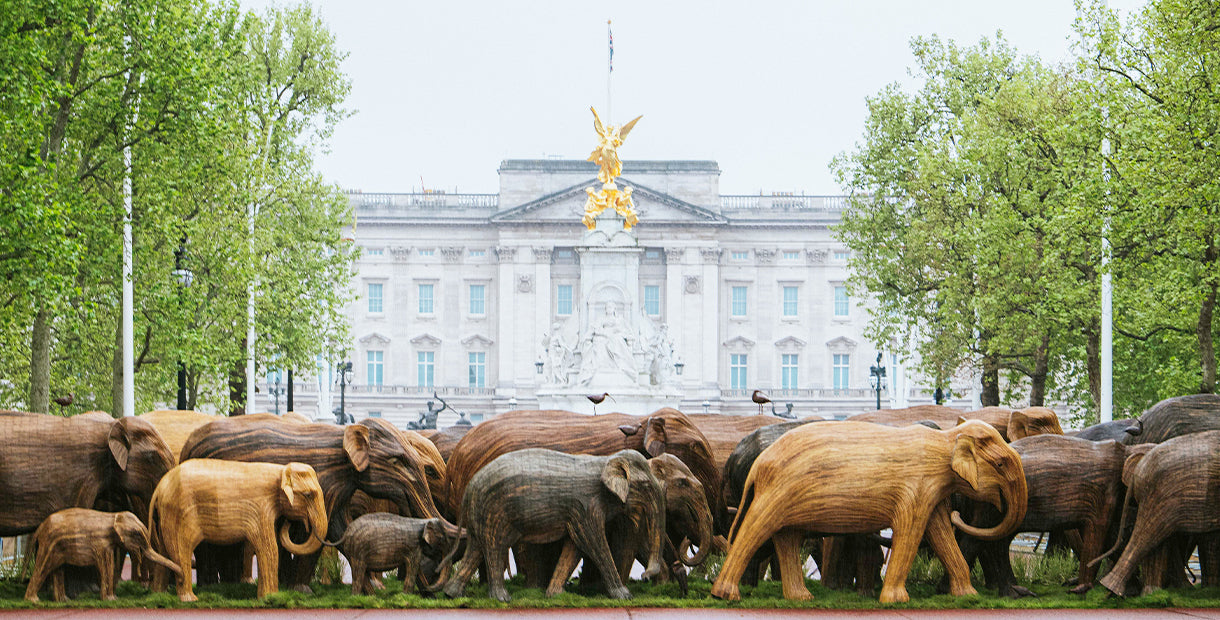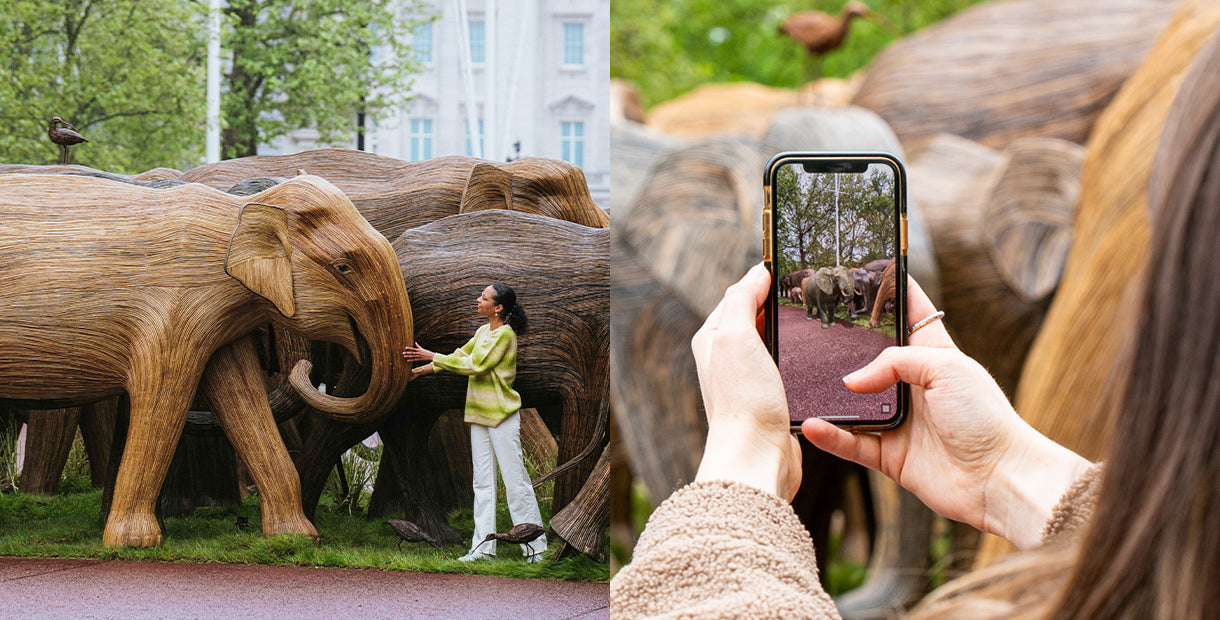
The elephant herd takes over the Mall in front of Buckingham Palace
Why Did The Elephant Cross The Road?
Making tracks across London this summer, these elephants—co-sponsored by Chantecaille—share an urgent message about human-wildlife coexistence.
On Monday June 14, a herd of 100+ elephants—tuskers, matriarchs, adolescents, and calves—wandered into London’s Royal Parks, including Green Park, St. James’ Park and Berkeley Square. The life-size creatures are modelled on real wild elephants from the Nilgiri Hills in Southern India. They are part of CoExistence, a public artwork project brought to life by UK-based charity Elephant Family and co-sponsored by Chantecaille, designed to raise awareness and encourage action around reducing human-wildlife conflict. They will be on display in the parks until July 23rd.
And so, the answer to (a variation of) the age-old question about street perambulations is: because the elephants have nowhere else to go. The scene is reminiscent of a common sight in places like Southern India, where a rapidly growing human population and modern development, coupled with the destruction of forests, causes wild habitats to shrink, leaving less room for elephant herds to roam freely. The elephants in search of food and space come into contact with humans, causing conflict that can be harmful, even deadly.
The 100-strong herd were created deep in the jungles of Tamil Nadu in Southern India by indigenous communities who live near their real-life counterparts. The material they’re made from, lantana camara, is an invasive weed whose removal from protected areas als benefits wildlife. Perched on the backs of the herd are flocks of extinct or endangered British birds such as the nightingale, curlew, dalmatian pelican and turtle dove, drawing attention to the biodiversity lost in the UK and to the co-existence vision of WildEast, a farmer-led initiative that is calling for 20 percent of land to be returned to nature recovery to bring back wild landscapes.

The elephants are made in Southern India out of lantana camara, an invasive weed.
FOLLOW THE CHANTECAILLE HERD
The elephant herd first landed on May 15 at the Mall in front of Buckingham palace, which was shut down for the occasion, before beginning their 6-week migration path through London’s Royal Parks. The largest herd is on the move from Green Park tube station, down the Broad Walk towards Buckingham Palace. The second herd—the “Chantecaille herd”—is now meandering around St James’s Park lake, their watering hole. The final herd is isolated from the rest in Berkeley Square, representing all wildlife living in increasingly fragmented and human-dominated habitats.
"We are beyond excited to support this extraordinary effort imagined and brought to life by the Elephant Family—bringing 100 life-size elephants to London to make everyone aware of the difficulty of coexistence between wild animals and humans," Sylvie Chantecaille says. “As we grow our populations everywhere, it becomes harder and harder to preserve these wild spaces for wild animals. CoExistence is a shining example of what can be achieved if we all think about it, get creative and work together.”
“We are beyond excited to support this extraordinary effort imagined and brought to life by the Elephant Family—bringing 100 life-size elephants to London to make everyone aware of the difficulty of coexistence between wild animals and humans.”

The herd, clockwise from top left: Sir David Attenborough; Taru and Roan Carr-Hartley; their mother, Angela Sheldrick; Stephanie Dolrenry; Lisa Hywood; Raman Sukumar; Sylvia Earle; Vivek Menon; Leela Hazzah; Max Graham.
Sylvie Chantecaille named our herd in recognition of some conservationists—both iconic and next-generation—who work to enable coexistence between people and wildlife. They include:
Sir David Attenborough (Tusker)
Pioneering naturalist, advocate for biodiversity and the patriarch of wildlife-focused programming, Sir David Attenborough has educated millions by bringing the natural world into our homes.
The Carr-Hartley Brothers: Taru & Roan (Calf)
Taru and Roan Carr-Hartley's formative years were shaped by their grandmother, the pioneering conservationist Dame Daphne Sheldrick. Today, they continue their family's legacy to safeguard Kenya's wildlife and wild places. An accomplished helicopter pilot and field guide, Taru is involved in all aspects of the Sheldrick Wildlife Trust’s work, particularly human-wildlife conflict mitigation, animal rescue, and aerial operations. At 20 years old, Roan is a young conservationist who’s grown up alongside rescued wildlife at the Sheldrick Trust. Well-versed in the intricacies of saving an individual life, as well as the complexities in protecting entire species, his appreciation of the natural world and skills as a pilot make him an invaluable asset now and for the future.
Angela Sheldrick (Matriarch)
Born and raised in Kenya, Angela is the daughter of acclaimed conservationists David and Daphne Sheldrick. Building upon her family’s incredible legacy, Angela is today the driving force behind the Sheldrick Wildlife Trust. Under her stewardship, the Trust has expanded its field initiatives to meet the conservation challenges posed by the modern world; implementing programs that secure habitats, protect wildlife, and respect the needs of local communities to create a more harmonious existence for all species.
Stephanie Dolrenry (Matriarch)
The Director of Science and co-founder of Lion Guardians, Dr. Stephanie Dolrenry has studied human-wildlife conflict throughout North America and East Africa and has spent more than a decade leading researchers and Maasai warriors to reduce retaliatory killings of lions in Kenya. She is committed to improving the sustainability and effectiveness of conservation efforts, as well as role-modeling innovation and cooperation in conservation.
Tikki (Matriarch)
In 1994 Lisa Hywood created the Tikki Hywood Foundation in Zimbabwe in memory of her father, to bring awareness and sound conservation action to the plight of lesser known and threatened animals, especially the rescue, rehabilitation and release of the highly endangered pangolin.
Raman Sukumar (Calf)
An ecologist best known for his work on the Asian elephant and human-wildlife conflict, Dr. Raman Sukumar also works on climate change and tropical forest ecology. To provide a safe habitat for elephants, Sukumar pioneered a survey system and established protected corridors so that elephant herds could move from one reserve to another in his homeland of India and across Asia.
Sylvia Earle (Matriarch)
Legendary oceanographer, marine biologist and founder of Mission Blue, which has established Marine Protected Areas around the globe, Dr. Sylvia Earle – nicknamed “Her Deepness”— has inspired generations to explore and protect the ocean.
Vivek Menon (Calf)
Vivek Menon is a wildlife conservationist, environmental commentator, author and photographer with a passion for elephants. He has been part of the founding of multiple environmental and nature conservation organizations in India and is Chairperson of the IUCN SSC Asian Elephant Specialist Group. His work with Elephant Family reconnects the habitats of the Asian elephant through a network of 101 elephant corridors.
Leela Hazzah (Matriarch)
The Executive Director and co-founder of Lion Guardians, Dr. Leela Hazzah has worked on conservation issues in East Africa for twenty years. Her work focuses on increasing tolerance for wildlife in Maasailand, Kenya, with dramatic results for lions on community lands. She is passionate about working hand-in-hand with communities, employing innovation to further conservation goals, and supporting conservationists in sharing knowledge.
Max Graham (Male adolescent)
Dr. Max Graham has been involved in studying and conserving elephants in Africa for 20 years. In 2011, Graham founded Space for Giants to help lead efforts to combat human-elephant conflict and the illegal ivory trade in central Kenya. With a view to scaling their impact across Africa, Space for Giants combines political, social and financial muscle through its Giant’s Club to help protect at least half of Africa's elephants and the landscapes they depend on. Graham continues to lead Space for Giants' work in 10 African countries with an increasing focus on attracting conservation and tourism investment to sustain the continent's remaining natural ecosystems.

Can't make it to London? Take a photo of an Augmented Reality elephant using our app, Chantecaille Wild Beauty
ROOM TO ROAM
At the end of the event, the elephant herds will be sold, and the anticipated £2m raised from will fund a range of innovative conservation programs in South Asia to reduce human-wildlife conflict, largely through community-centered efforts that address the needs of both people and animals. It will also be used to halt the destruction of forests by increasing land protections and reconnecting forest fragments, enabling safe movement for wildlife.






